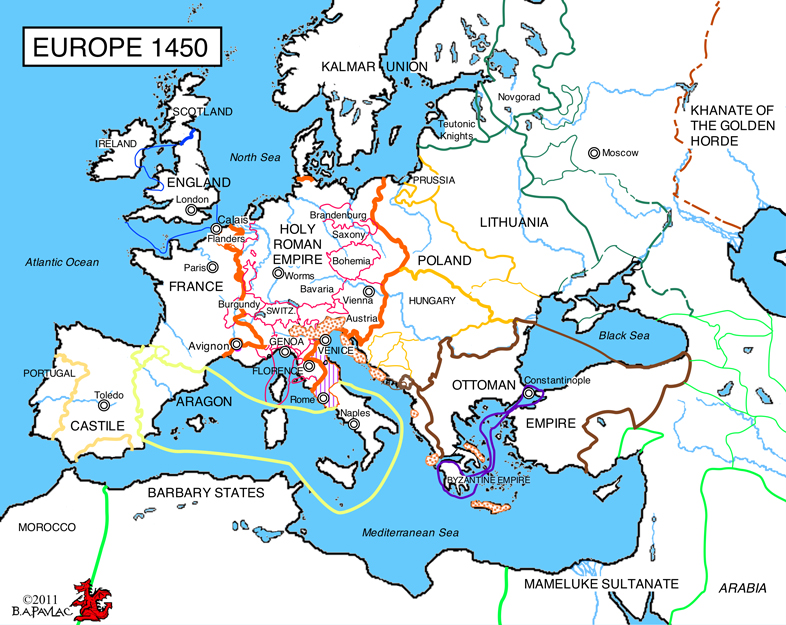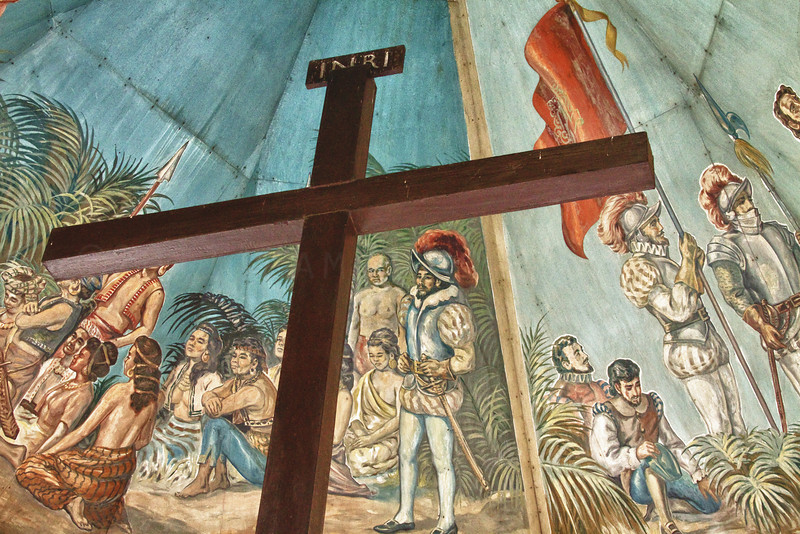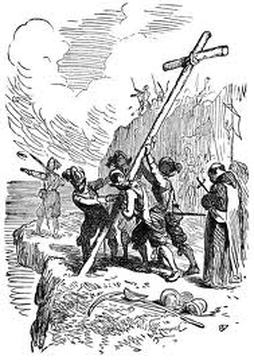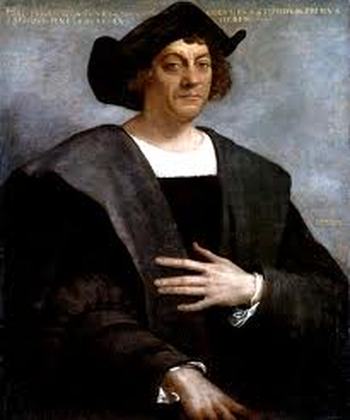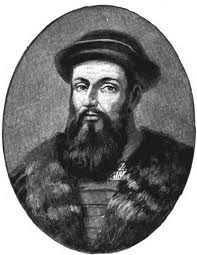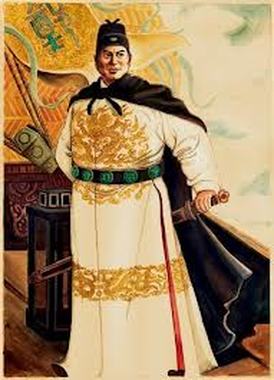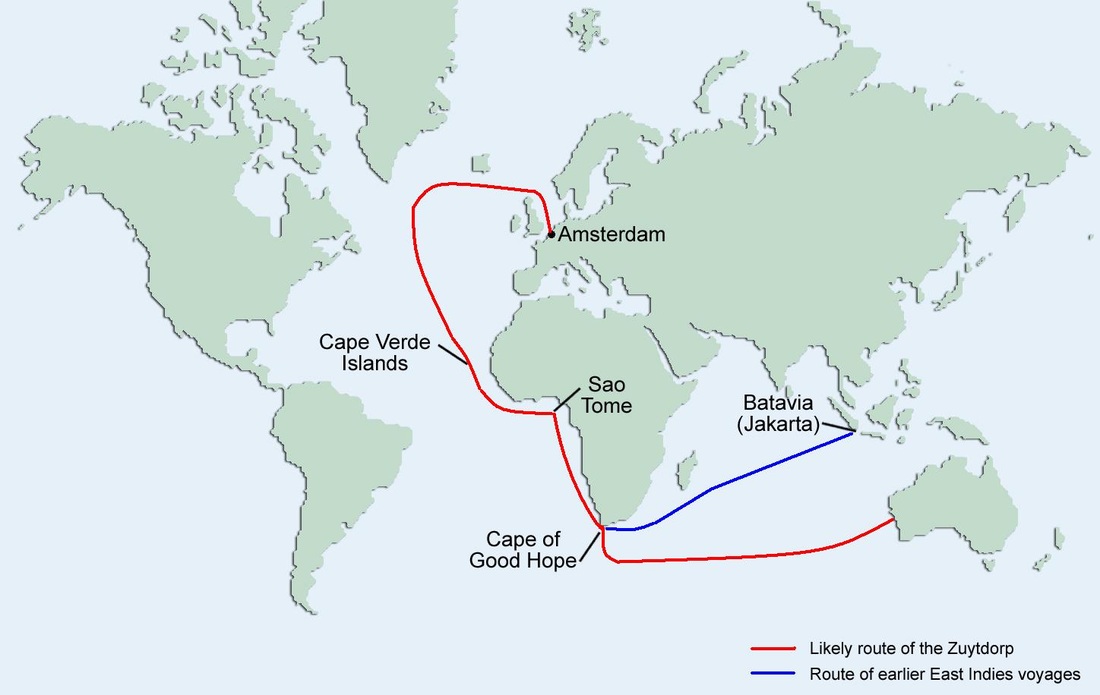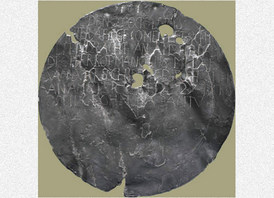Basic Gist
Compare and Contrast
Spanish, English, Portuguese, Ming Chinese, and the Dutch
1. One commonality that all of the European nations which participated in the exploration of the world from 1450-1750 was the importance in the spread and conversion of their religion to the native people. During this time period, the respective churches played large roles in the politics of each individual European state. The lust for expanded power in the church was one of the key driving forces in all of the European states. This is specifically seen in Spanish explorations with the attempt to convert the natives of Central and South America to Christianity and the attempt from Portuguese explorers to convert natives of Africa and Southern America to Catholicism. England on the other hand, while still driven by religious means, was slightly different in the fact that religions used the Americas as a means to branch out and establish their own separate powers away from the Church of England. Due to England’s immense push of reading the bible in their colonies, their literacy rates were higher than that in other nation’s colonies. However, religion as a driving force for expansion was not a commonality throughout the whole world. Unlike Europe, China had little interest in the spread of their religion because of the generally more tolerant attitude of Confucianism when compared to the competitive European religions and the strict beliefs of cultural conservation.
2. The accumulation of wealth by means of imperialism was also a major factor in Europe’s attempt to colonize the world. Motivated by the intense competition throughout Europe, states such as Spain, Portugal, England, and the Netherlands all attempted to imperialize areas in order to exploit either the natural resources or the manpower present in the areas. All of the European nations found great wealth through the trade of crops such as: the potato, sugar, tobacco, and cotton, precious minerals such as: gold, silver, and coal, and the African Slave trade. For the first time, all four continents were connected in global trade due to the colonies established by the Europeans. China, although was different in their method of obtaining wealth through explored areas, shared the motivation of wealth with Europe. Unlike Europe, China did not intend to exploit the natural resources or labor of the areas, however, integrated into a tribute system which allowed them to obtain wealth while conserving their coveted cultural values.
3. The attitudes in China differed from those of Europe. This was due to the different environments that they developed in; while Europe was composed mainly of competing nations that were relatively equal in power, China was the most dominant force in their region. Competition motivated the Europeans to send as many explorers as possible, in hopes of gathering more wealth from the Americas so they could beat the other nations. However, China knew they were the strongest, not only in their area, but all around the world. They were satisfied, which contributed to their stagnant growth. Rather than conquering, they chose to display their immense power through the use of treasure ships and large fleets. The culture of China also prevented them from expanding. They were focused on preserving, rather than exploring, further adding onto their isolation. Unlike the Europeans, China was not geographically located in a convenient spot to reach the Americas. They were isolated in this manner by deserts and dangerous waters. The Europeans were located on the Atlantic coast, which gave them the edge to expand their influence easily across oceans.
4. A contrast that is seen between the European nations and China is the interest in America. China, which is rumored to have discovered America before the Europeans, made no serious attempt to colonize the newly discovered land. This was an extremely large contrast to the European nations that underwent exploration during this time period. Spain and England were extremely interested in the colonization of all parts of America, spreading their reach from the Hudson Bay in Canada to the Southern tips of South America. Portugal was interested in the colonization of America, however it was not as widespread as the other European nations, and mainly colonized what is now Brazil. This is a major difference because it showed the separation in the motivation between the European explorations and the Chinese and Asian explorations. Europe was much more interested in expanding their borders to other areas while China was content with the territory that it was confined to in Asia.
2. The accumulation of wealth by means of imperialism was also a major factor in Europe’s attempt to colonize the world. Motivated by the intense competition throughout Europe, states such as Spain, Portugal, England, and the Netherlands all attempted to imperialize areas in order to exploit either the natural resources or the manpower present in the areas. All of the European nations found great wealth through the trade of crops such as: the potato, sugar, tobacco, and cotton, precious minerals such as: gold, silver, and coal, and the African Slave trade. For the first time, all four continents were connected in global trade due to the colonies established by the Europeans. China, although was different in their method of obtaining wealth through explored areas, shared the motivation of wealth with Europe. Unlike Europe, China did not intend to exploit the natural resources or labor of the areas, however, integrated into a tribute system which allowed them to obtain wealth while conserving their coveted cultural values.
3. The attitudes in China differed from those of Europe. This was due to the different environments that they developed in; while Europe was composed mainly of competing nations that were relatively equal in power, China was the most dominant force in their region. Competition motivated the Europeans to send as many explorers as possible, in hopes of gathering more wealth from the Americas so they could beat the other nations. However, China knew they were the strongest, not only in their area, but all around the world. They were satisfied, which contributed to their stagnant growth. Rather than conquering, they chose to display their immense power through the use of treasure ships and large fleets. The culture of China also prevented them from expanding. They were focused on preserving, rather than exploring, further adding onto their isolation. Unlike the Europeans, China was not geographically located in a convenient spot to reach the Americas. They were isolated in this manner by deserts and dangerous waters. The Europeans were located on the Atlantic coast, which gave them the edge to expand their influence easily across oceans.
4. A contrast that is seen between the European nations and China is the interest in America. China, which is rumored to have discovered America before the Europeans, made no serious attempt to colonize the newly discovered land. This was an extremely large contrast to the European nations that underwent exploration during this time period. Spain and England were extremely interested in the colonization of all parts of America, spreading their reach from the Hudson Bay in Canada to the Southern tips of South America. Portugal was interested in the colonization of America, however it was not as widespread as the other European nations, and mainly colonized what is now Brazil. This is a major difference because it showed the separation in the motivation between the European explorations and the Chinese and Asian explorations. Europe was much more interested in expanding their borders to other areas while China was content with the territory that it was confined to in Asia.
Spanish ExplorationsThe Spanish began their expeditions in 1492 when Christopher Columbus received the funding from the crown to find a faster route to the Indies to bypass the Portuguese around Africa. Once the nation became stabilized after religious battles, they finally set their focus on finding a route to Asia. The Spanish frequently butted heads with the Portuguese so much that a treaty was drawn up, called the Treaty of Tordesillas in 1494, which drew a north-south line through the Atlantic Ocean. Everything east of the line was to belong to Portugal, and everything west was for Spain. The Spanish led many expeditions, mainly around the Caribbean, South America, and the southern region of North America. The Spanish were focused on creating colonies in the Americas and using them to spread Christianity and direct wealth back to the mother country of Spain. The huge import of silver provided one-fifth of Spain's total budget, but it also led to the decline of the nation when inflation hit. The explorers and conquistadors also brought diseases to the New World, such as smallpox, flu, and typhus, crippling native populations. The Spanish conquistadors are responsible for the wipeout of the Aztec and Incan empires in South America due to their refusal to accept Christianity and bow to the Spanish. Finally, in 1513, the Spanish laid eyes on the Pacific Ocean, courtesy of the explorer, Vasco de Balboa.
|
Motives for Exploration
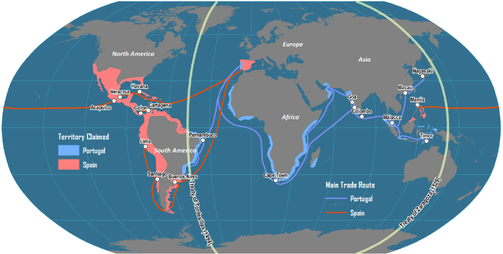
Spain's routes in the Age of Discovery focused on traveling west.
1. The Spanish were motivated in many ways. A huge force was the drive to find the Northwest Passage to reach Asia. The Spanish were set on getting their hands on the silks, spices, and wealth of Asia. To find this alternate route, the Spanish set out Christopher Columbus to sail west. He discovered the Americas, which were what he presumed to be the Indies.
2. The Spanish wanted to conquer new lands to expand their empire and influence. Due to intense competition between neighboring nations in Europe, the Spanish wanted to expand their realm to be the best. Unlike Asia, the Americas was not very developed, so they did not have as much to offer in terms of trade. Instead of trying to trade, the Spanish overcame the people by force and focused more on colonization.
3. The Spanish wanted to spread their religion of Christianity. They felt superior in their religion, so they wanted to convert people to this "better" religion. Many missionaries were sent out to convert the natives of the Americas. When confronted with Catholicism, the native americans in Mesoamerica and Peru generally blended their practiced cutsoms with the new Catholic ones.
4. The Spanish wanted to bring back wealth for their country. For example, they wanted to find mineral wealth by finding El Dorado, which is known as the City of Wealth. By establishing colonies, wealth and raw resources can be exported back to Spain to fund the crown.
2. The Spanish wanted to conquer new lands to expand their empire and influence. Due to intense competition between neighboring nations in Europe, the Spanish wanted to expand their realm to be the best. Unlike Asia, the Americas was not very developed, so they did not have as much to offer in terms of trade. Instead of trying to trade, the Spanish overcame the people by force and focused more on colonization.
3. The Spanish wanted to spread their religion of Christianity. They felt superior in their religion, so they wanted to convert people to this "better" religion. Many missionaries were sent out to convert the natives of the Americas. When confronted with Catholicism, the native americans in Mesoamerica and Peru generally blended their practiced cutsoms with the new Catholic ones.
4. The Spanish wanted to bring back wealth for their country. For example, they wanted to find mineral wealth by finding El Dorado, which is known as the City of Wealth. By establishing colonies, wealth and raw resources can be exported back to Spain to fund the crown.
Spanish Explorers
|
Christopher Columbus
In total, Christopher Columbus made four voyages to the Americas from 1492 to 1503. The Spanish were looking to bypass the Portuguese monopoly over the African routes and find a quicker way to reach the Indies in Asia. His mission was to find a western route to the West Indies, taking off from Palos, Spain. His first expedition took off in 1492 when he finally received funding, after being rejected twice by King John II of Portugal. Columbus crossed the Sargasso Sea on route to America, and he landed in present day San Salvador on October 12, 1942. Thinking that the earth was much smaller, Columbus believed that he had arrived in the East Indies. In this trip he also explored the northern coasts if Hispaniola and Cuba. A major accomplishment of his was founding La Navidad in present day Haiti, the first colony of the New World. He left behind thirty-nine men in La Navidad, while he kidnapped ten to twenty-five natives to bring back to Spain. Unfortunately, only approximately eight natives survived the trip back to Spain. Arriving back in Spain, word spread about the finding of new lands to the west, which furthered later expeditions. Christopher Columbus opened up the New World for colonization from the Spanish and lit the spark. It was on Columbus's second voyage that he took the people and the resources to establish permanent colonies in the Americas. These colonies were to work at converting the natives to Christianity. Columbus's third voyage was to travel south of the Caribbean to hopefully find a route to Asia. His fourth voyage was a mission to find the Strait of Malacca in hopes of reaching the Indian Ocean. In his voyages, he failed to locate the gold and spices that he sought after. |
Pizarro and Cortes
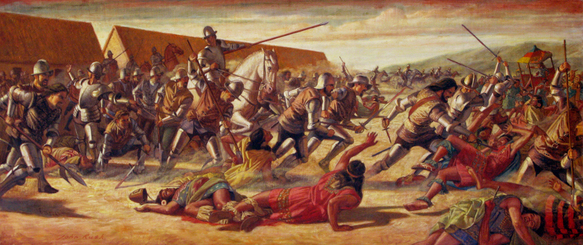
Pizarro, using superior weaponry, conquered the Inca Empire with ease.
Francisco Pizarro and Hernando Cortes both set out on separate missions to South America. Cortes conquered the Aztec empire in 1519, and Pizarro conquered the Incan empire in 1526, both of which taking over by force and bloodshed. For the Aztecs, the neighboring civilizations were very cooperative in helping the Spanish conquer the Aztecs because they were used by the Aztecs as victims of sacrifice for religious rituals. They used the Spanish as an aid to get an advantage over the Aztecs. However, if they did not cooperate with the Spanish, they were killed. At first, the Spanish were perceived as Gods because of their pale skin and horses, so they were sent gifts, but this only fueled the Spanish's desire to steal their wealth. Pizarro wielded the power of disease, superior weapons, and enemy help to easily overcome the Incas. The natives' military tactics were simply to use ambush, but the Spanish had superior tactics and weaponry. A huge advantage that the Spanish had were horses and steel, both instilling fear into the natives and a dominant form of military. Both conquistadors stripped the civilization for all it was worth, taking all of the gold and wealth, and then killing the ruler. The abundance of wealth in these empires added to Spain's riches.
Portuguese Explorations
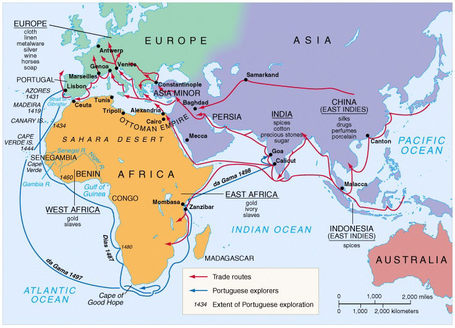
Portuguese exploration opened many trade routes with Asia
Portugal played an extremely large role in the exploration of the world during the time period of 1450-1750. Increased exploration of Central America and Asia led Portugal to become one of the most prosperous states in Europe because of the exotic goods present in these areas. The Portuguese explorers shared many commonalities with other European explorers, mainly their motivation.
- Wealth from other areas. It was a known fact during this time period that the Asian continent held goods that were coveted by Europeans, and any explorer that could form trade relations with Asian civilizations opened up a vast supply of goods that were extremely sought after and expensive in Europe.
- Along with the wealth that was experience through trade connections made by exploration was a large increase in both political and military power. During this time period, many of the European states were competing with each other to become the most powerful and successful nations. Kings and Queens of states realized that they needed to branch out to expand their power, which lead to the funding of many explorations around the world
- Another key factor in the Portuguese lust for exploration was the conversion of locals to Catholicism. Throughout Portuguese history, the church played a large role in influencing both the military and political decisions of the state. Increased spread of their religion granted the church much larger power throughout the world which in turn increased its power in Europe.
Ferdinand MagellanMagellan was an extremely important Portuguese explorer because he was the first person to lead an exploration that completely circumnavigated the globe. He is also responsible for the discovery of the Philippines in 1521. Magellan was extremely important to the history of he world because he reconnected contact with Asia by becoming the first person to sail from the Atlantic ocean to the Pacific ocean, opening up communication with Asia once again. Another great impact that came from his circumnavigation voyage was the knowledge obtained throughout his travel. Traveling around the world, his crew was able to document and map out many areas, including South America and the Spice islands of the Philippians.
|
Ming Chinese Explorations
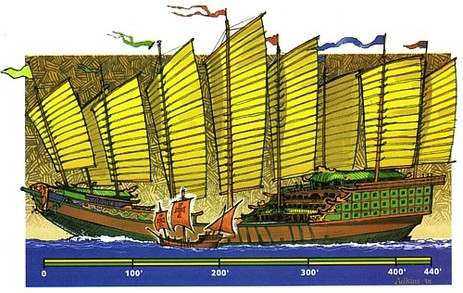
The Chinese were known for their vast and luxurious treasure that were unmatched anywhere else
Starting out in the late 1300’s, the Ming dynasty quickly emerged after taking over the Yuan dynasty. Using their military advantages, the first two emperors showed their immense power with successful military campaigns in the surrounding areas. When it came time to the third emperor, Zhu Di, also known as the Yongle Emperor, he emphasized aggression and wanted to display their power to the world. As a result, he placed Zheng He, one of his most trusted generals, in charge of a series of expeditions across the seas, arming him with the worlds most powerful navy. The purpose of these expeditions were to show the rest of the world how superior Ming China was, as well as to establish diplomacy with other foreign powers. Over a course of a seven journeys, Zheng He reached from south east asia and India, to the Persian Gulf, and even all the way to the east coast of Africa. His fleet consisted of hundreds of ships, tens of thousands of sailors and crewmen, and many treasure ships, luxurious ships that showed the immense wealth they owned. They presented gifts along their journeys, such as silk, porcelain and gold, while receiving novelties such as ostriches and zebras. However, the motivation behind China’s expeditions, the factious groups within the State, and the death of Zheng He all contributed to the steady downfall of Ming China and their explorations.
Ming Chinese: Zheng He
|
Zheng He, also known as Cheng Ho, was not born in Ming China, but rather to a Muslim family in the far south west of Asia. Captured at the age of 10 by Ming soldiers, he was trained to be part of the military. He quickly moved up the ladder, making important allies in the political scene, one of them being the Yongle Emperor. When it came time for an ambassador with an Islamic background, he was the man of choice. Even more importantly, he was handpicked by the Zhu Di to command the massive fleet that would go through a series of seven voyages. His first few voyages were to India and Thailand. On his fourth expedition, he went to the Persian Gulf, and finally his last three voyages lead him to Eastern Africa. During his journeys, he suppressed pirates, disposed of a King and a Sultan that opposed Ming China, as well as bearing gifts for friendly diplomacy. However, upon coming back from his last expedition, Zheng He died and was buried at sea. As a result, his already declining faction disintegrated and there were very little people that still supported sea explorations in China.
|
(Lack of) Motivations for Exploration
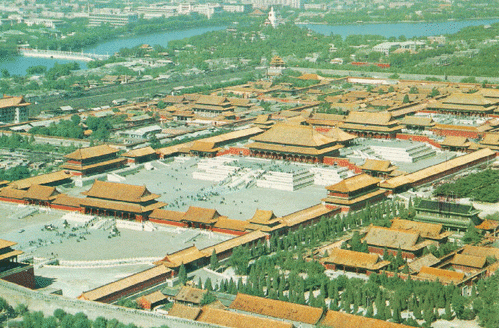
The Yongle Emperor used many resources to move the Capital, and build the Forbidden City
1. The Chinese did not see exploration as a commercial venture; they were economically satisfied with the wealth that they had received from the tribute system. The purpose of their expeditions was due to the Yongle Emperors ambition to make the reset of the world recognize the power of the Ming Chinese. This was displayed through the fleet of battleships and treasure ships, that were far more advanced than anyone else at the point.
2. The Chinese population was stable, and from their perspective, economical success could be achieved by trading with themselves and collecting tribute. This led them to turn away foreigners from their country, as they did not believe that anything foreign could benefit them.
3. Factions within the state opposed the Yongle Emperors polices, and there was a constant struggle for power. Opposing factions disliked the Yongle Emperor's use of resources, depleting much of the treasury through the seven expeditions as well as the relocation of the Capital from Nanjing to Beijing. The building of the Forbidden City in Beijing required millions of workers, and many saw it as unnecessary and wasteful. Combined with the losing battle against the Annam in northern Vietnam, and the banding of multiple mongol tribes in the north, the Yongle Emperor fell out of favor. The timing of Zheng He's death did not help either, and by the mid 1400s there was nothing stopping the transition of power.
4. With the new conservative faction taking over, they revived Confucianism, and made it their own Neo Confucianism. In attempts to preserve their culture, they prevented Europeans from spreading Christianity by isolating themselves as much as they could. The idea of expansion and exploration was also alien to the conservative group, and they saw no benefits from it other than depleting resources that were needed to defend themselves. This led to the government ordered destruction of all ocean going ships to be destroyed in 1525.
2. The Chinese population was stable, and from their perspective, economical success could be achieved by trading with themselves and collecting tribute. This led them to turn away foreigners from their country, as they did not believe that anything foreign could benefit them.
3. Factions within the state opposed the Yongle Emperors polices, and there was a constant struggle for power. Opposing factions disliked the Yongle Emperor's use of resources, depleting much of the treasury through the seven expeditions as well as the relocation of the Capital from Nanjing to Beijing. The building of the Forbidden City in Beijing required millions of workers, and many saw it as unnecessary and wasteful. Combined with the losing battle against the Annam in northern Vietnam, and the banding of multiple mongol tribes in the north, the Yongle Emperor fell out of favor. The timing of Zheng He's death did not help either, and by the mid 1400s there was nothing stopping the transition of power.
4. With the new conservative faction taking over, they revived Confucianism, and made it their own Neo Confucianism. In attempts to preserve their culture, they prevented Europeans from spreading Christianity by isolating themselves as much as they could. The idea of expansion and exploration was also alien to the conservative group, and they saw no benefits from it other than depleting resources that were needed to defend themselves. This led to the government ordered destruction of all ocean going ships to be destroyed in 1525.
Northern Europe Explorations
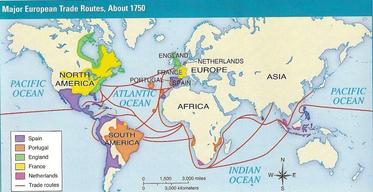
Northern Europe nations had a reputation for privateering explorers to go on expeditions. However, after the Dutch rebelled against Spanish rule, the Spanish King Phillip II would go on to combining Spain and Portugal as he received the Portuguese throne through inheritance. It would not be until the Spanish Armada was defeated, before the Netherlands and England in northern Europe could rise and explore freely. While the Dutch focused primarily on the Spice Islands near southern Asia, the English explored North America, both establishing settlements. The emergence of these two nations led to the creation of the English and Dutch chartered companies, each competing each other as well as other European nations in explorations. It was the competition that motivated expansion and settling
Netherlands: Dirk Hartog
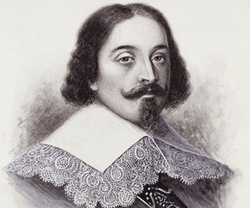
Dirk Hartog, a 17th century Dutch explorer.
Dirk Hartog, a Dutch 17th century sailor and explorer was born into a family of sailors so it came as no surprise when he became the captain of small trading ship called the Dolphyn in 1615. Soon after, in 1616, Hartog decided to join the Dutch East Indies Company which was located in Batavia (now part of Indonesia). Dirk Hartog, after gaining employment with VOC, was appointed master of the Eendracht and was scheduled to be part of a fleet heading from the Netherlands through South Africa where the crew would end in Batavia. In 1611 Hendrik Brouwer had discovered a new route to Batavia that was supposed to cut sale time in half. However, after setting sale, Hartog’s ship was separated from the rest of the other ships and landed at the Cape of Good Hope. From there, Hartog set off, only to be blown by strong Western winds to an uninhabited island which he called Dirk Hartog Island and what is know today as Australia. Although Hartog did explore Western Australia for a few days, he was unimpressed and soon decided to continue on with his journey to Batavia. Before doing so though, he left a flattened and engraved pewter plate (now called a Hartog plate). This plate included a recording of his voyage and also his destination. Years later, in 1696, Willem de Vlamingh landed on Dirk Hartog Island and after finding the pewter plate, replaced it with his own and brought Hartog’s plate to Amsterdam. Not only did Hartog’s action continue a tradition of explorers leaving reminders of their visits, but Hartog’s landing in Australia also spurred on many more explorations to Australia by the Dutch, English and French. Dirk Hartog’s legacy will live on as he will be remembered as being the second European group to land on Australian soil and the first explorer to map the Western coast of Australia.
Motivation for Exploration
1- During the early 1600s, the Dutch East Indies Company (VOC) controlled the East Indies spice trade which was very lucrative. Because this spice trade was such a profitable resource for VOC, the Dutch were constantly searching for a shorter and more efficient travel route that would make traveling faster and in the end, help the Dutch to acquire, and trade, more goods and knowledge.
2- The Dutch were also interested in developing colonies. This helped spur on their motivation for exploration because not only did they use their voyages to help find a faster route to India and the spice trade, but they also used this exploration as a chance to colonize. AlthoughThe Dutch did set up New Netherlands on the East Coast of North America, colonizations was very slow. However, some came and did take part in the fur trade and expand the Dutch culture, which is still present on the East Coast today.
3- The route that the Dutch took to travel to parts of Asia was very unpredictable because of the strong Western winds. This made traveling unpredictable and often a great risk for not only the sailors, but also those backing the voyages. This further encouraged for a new and safer route to be found.
2- The Dutch were also interested in developing colonies. This helped spur on their motivation for exploration because not only did they use their voyages to help find a faster route to India and the spice trade, but they also used this exploration as a chance to colonize. AlthoughThe Dutch did set up New Netherlands on the East Coast of North America, colonizations was very slow. However, some came and did take part in the fur trade and expand the Dutch culture, which is still present on the East Coast today.
3- The route that the Dutch took to travel to parts of Asia was very unpredictable because of the strong Western winds. This made traveling unpredictable and often a great risk for not only the sailors, but also those backing the voyages. This further encouraged for a new and safer route to be found.
------------------------------------------------------------------------------------------------------------------------------------------------------------------------------------------------------------------------------------------------------------------------------------------------------------
England: Henry Hudson
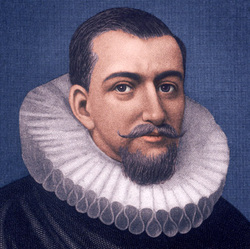
Henry Hudson, a 17th century English explorer.
Although today Henry Hudson is very well-known for his exploration of Canada, North America and Arctic Ocean, there is very little known about his life before he became a sailor. It is believed he was born in the 1600s and that he grew up with sailors and fisherman where he not only learned to sail, but also navigation. Hudson was hired by the Muscovy Company of England to find a northern route to the Pacific coast of Asia, allowing for faster travels. It was believed that the ice in the Arctic would melt, allowing for Hudson to sail across the top of the world. However, Hudson and his crew soon had to turn back when the ice became too thick. In 1608, Hudson was sent by the Muscovy Company and English merchants of the East India to once again try and find a passageway. This time, Hudson set off during the summer in hopes that the ice would not stop their voyage. Unfortunately, even in the summer the ice was too dense and Hudson and his crew headed back to England. Although on both of these voyages Hudson failed to find a Northwest passage above the Arctic, Hudson not only discovered Whale’s Bay, which started the coal mining industry, but he also documented the Great Barrier Reef, talked about the natives he came in contact with, and expanded the human knowledge of the Pacific Ocean. Then, in 1609, Hudson was hired by the Dutch East India Company in the hopes that he would find an East passage to Asia. Once again, the voyage failed because of ice, however this time Hudson decided to voyage West with the interest in finding another passage. Hudson landed upon Nova Scotia and then continued to sail South. He then discovered a bay, which is now called Hudson Bay. Hudson continued South where he discovered the estuary of the North River, what is now referred to as the Hudson River. Hudson is also credited with discovering what is now New York. He reported an abundance of rich land and good harbors, causing for many English and Dutch to later settle in the New York area. Soon after returning to England, the Virginia Company and British East India Company sent Hudson, in 1610, on another voyage. This time Hudson sailed to Iceland and then to Greenland. Many believed Hudson had finally discovered the Northwest Passage to China. Hudson and his crew reached what is today called the Hudson Strait leading them to the Hudson Bay. Hudson spent months mapping the Eastern shore of Canada but was still unsuccessful in finding a cut through to Asia. Unfortunately, mutiny occurred after the crew was forced to move ashore for winter. When the ice finally cleared, Hudson disagreed with his company on where to go next, so the crew abandoned him, his son, and many other crew members in open water in a small ship never to be seen again. Although Hudson never did find a passage to Asia, the bay that Hudson discovered in Canada allowed for him and the companies he worked for to capitalize on a profitable fur trade for more than two centuries. Henry’s exploration in the New York metropolitan area led to the naming of the Hudson River.
Motivation for Exploration
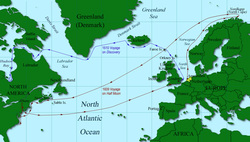
Hudson's route to North America and the Arctic.
1- When Constantinople fell to the Ottomans, the Europeans began having to pay very high trade taxes on the transportation of Europeans goods to the East. The Europeans hoped that if they could find an alternate route that was not controlled by the Ottomans they could gain more wealth and knowledge for a much cheaper price of transit since they would by pass the tax.
2- The waters around the point of South Africa (the Cape of Good Hope) were very unpredictable and dangerous. Many sailors who voyaged this route were lost at sea or blown off course causing for goods and money to be wasted.
3- The English knew that India not only had spices but gold. The English were on a search for an efficient and cheap way to get rich fast. This was the driving motivation behind the English searching for an alternative route that would avoid danger, the middle-man and make travel shorter.
2- The waters around the point of South Africa (the Cape of Good Hope) were very unpredictable and dangerous. Many sailors who voyaged this route were lost at sea or blown off course causing for goods and money to be wasted.
3- The English knew that India not only had spices but gold. The English were on a search for an efficient and cheap way to get rich fast. This was the driving motivation behind the English searching for an alternative route that would avoid danger, the middle-man and make travel shorter.
------------------------------------------------------------------------------------------------------------------------------------------------------------------------------------------------------------------------------------------------------------------------------------------------------------
Works Cited
No Author. "Christopher Columbus." Wikipedia. Wikimedia Foundation, 02 June 2012. Web. 04 Feb. 2013.
No Author. "Conquistador." Wikipedia. Wikimedia Foundation, 02 Aug. 2012. Web. 05 Feb. 2013.
No Author."Dirk Hartog." Wikipedia. Wikimedia Foundation, 21 Jan. 2013. Web. 05 Feb. 2013.
No Author. "Hartog & De Vlamingh." Western Australian Museum. Government of Western Australia, n.d. Web. 05 Feb. 2013.
No Author. "Henry Hudson - EnchantedLearning.com." Henry Hudson - EnchantedLearning.com. Enchanted Learning, n.d. Web. 05 Feb. 2013.
No Author. "Henry Hudson." Wikipedia. Wikimedia Foundation, 02 May 2013. Web. 05 Feb. 2013.
No Author. "Henry Hudson." All About Explorers. All About Explorers, 2013. Web. 05 Feb. 2013.
No Author. "Netherlands." Netherlands. Kidcyber, Oct. 2006. Web. 05 Feb. 2013.
No Author. "Spanish Colonization of the Americas." Wikipedia. Wikimedia Foundation, 02 May 2012. Web. 04 Feb. 2013.
Thompson, Stephen. "NSW Migration Heritage Centre." NSW Migration Heritage Centre. N.p., 2006. Web. 05 Feb. 2013.
Timestrider. "Bytes & Blogs – History of Australia." Bytes Blogs History of Australia. N.p., 17 May 2011. Web. 05 Feb. 2013.
No Author. "Christopher Columbus." Wikipedia. Wikimedia Foundation, 02 June 2012. Web. 04 Feb. 2013.
No Author. "Conquistador." Wikipedia. Wikimedia Foundation, 02 Aug. 2012. Web. 05 Feb. 2013.
No Author."Dirk Hartog." Wikipedia. Wikimedia Foundation, 21 Jan. 2013. Web. 05 Feb. 2013.
No Author. "Hartog & De Vlamingh." Western Australian Museum. Government of Western Australia, n.d. Web. 05 Feb. 2013.
No Author. "Henry Hudson - EnchantedLearning.com." Henry Hudson - EnchantedLearning.com. Enchanted Learning, n.d. Web. 05 Feb. 2013.
No Author. "Henry Hudson." Wikipedia. Wikimedia Foundation, 02 May 2013. Web. 05 Feb. 2013.
No Author. "Henry Hudson." All About Explorers. All About Explorers, 2013. Web. 05 Feb. 2013.
No Author. "Netherlands." Netherlands. Kidcyber, Oct. 2006. Web. 05 Feb. 2013.
No Author. "Spanish Colonization of the Americas." Wikipedia. Wikimedia Foundation, 02 May 2012. Web. 04 Feb. 2013.
Thompson, Stephen. "NSW Migration Heritage Centre." NSW Migration Heritage Centre. N.p., 2006. Web. 05 Feb. 2013.
Timestrider. "Bytes & Blogs – History of Australia." Bytes Blogs History of Australia. N.p., 17 May 2011. Web. 05 Feb. 2013.
